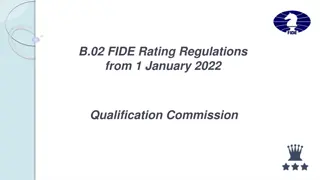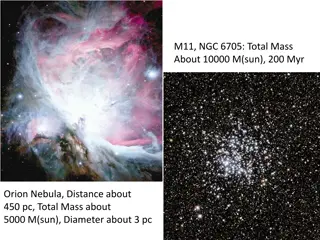Understanding the STAR Community Rating System
The STAR Community Rating System is a framework and certification program designed for local governments to assess social, economic, and environmental progress. It offers clear data-driven approaches and certification levels from 3-STAR to 5-STAR based on points earned. The Village of Park Forest, IL, achieved a 3-STAR certification in April 2015 and is working towards a 4-STAR rating. Joining STAR provides numerous benefits including aligning local plans with national sustainability frameworks, enhancing transparency, attracting funding, and promoting sustainability and resilience. The system also includes Goal Areas & Objectives to help measure progress across various sustainability themes.
Download Presentation

Please find below an Image/Link to download the presentation.
The content on the website is provided AS IS for your information and personal use only. It may not be sold, licensed, or shared on other websites without obtaining consent from the author. Download presentation by click this link. If you encounter any issues during the download, it is possible that the publisher has removed the file from their server.
E N D
Presentation Transcript
STAR Communities Village of Park Forest, IL Village of Park Forest, IL Certified 3-STAR Community April 2015
What is the STAR Community Rating System The STAR Community Rating System is the first framework and certification for local sustainability, built by and for local governments. STAR provides a clear data-driven approach to assessing social, economic, and environmental progress. Certification Levels Points range Certified 3-STAR Community Recognized for sustainability leadership 250 449 Certified 4-STAR Community Recognized for national excellence 450 649 Certified 5-STAR Community Recognized as top tier achiever in national sustainability 650+
Park Forest STAR certification The Village of Park Forest joined the STAR network as a Leadership Community in January 2014. As a member of the Leadership Program, the Village worked towards certification with a cohort of other communities from across the country. On April 16, 2015, Park Forest received recognition as a 3-STAR Community. Recertification is in progress- the final submission is due in April, 2019. The Village is working toward becoming a 4-STAR Community.
Reasons Park Forest Joined STAR Align local plans and priorities with a national sustainability framework Strengthen local metrics Demonstrate a commitment to data-driven performance management Increase transparency and accountability through public-facing reporting Identify gaps and prioritize future investment Gain competitive advantage and attract funding Catalyze action in implementing solutions and best practices for sustainability Communicate resilience and risk management to municipal bond agencies Integrate health and equity into existing sustainability or environmental efforts Build and brand a culture of local sustainability Improve sustainability communication and education Celebrate local progress and achieve national recognition
THE STAR COMMUNITY RATING SYSTEM Version 2.0 Released October 2016 Goal Areas & Objectives, helping local leaders set goals and measure progress across all areas. Aging in the Community
The STAR Framework GOALS Example: Built Environment BROAD SUSTAINABILITY THEMES WITH COMMUNITY-LEVEL ASPIRATIONS OBJECTIVES Demonstrate progress towards 80% reduction In energy use by 2050 ACHIEVEMENT INTENDED TO MOVE THE COMMUNITY GOAL TOWARD THE GOAL ACTION MEASURES Decisions, Investments, Activities taken by Community to achieve the Outcomes e.g. plan or ordinance revisions, education, partnerships, programs, incentives, capital improvements OUTCOME MEASURES Indicators that show progress toward the Goal trend lines, thresholds, targets e.g. Demonstrate progress towards 80% Reduction in energy use by 2050
Climate Reduce greenhouse gas emissions Maintain clean & healthful air Develop resiliency to climate change impacts Engage community in climate change mitigation & adaption Economic Development Promote innovation & a competitive workforce Cultivate local & sustainable development, jobs, & businesses Energy Use energy for buildings and facilities efficiently Advance renewable energy Reduce energy consumption Enact policies that support clean energy Engage the community in clean energy policies Land Encourage strategic development that upholds sustainability practices Conserve, restore & enhance natural features & ecosystems Support networks of accessible, well-used, & enjoyable parks Sustain a robust urban forest canopy Sustain beautiful landscapes that provide ecosystem services Achieve greater livability through sustainable land use & housing policies Cultivate a conservation ethic in the community Leadership Enlist support for GRC2 goals through regional, state & national leadership Advocate for policies that align with & advance the GRC2 Work collaboratively towards a sustainable region
Mobility Support safe & effective active transportation Maintain a diverse, safe, & efficient transportation network Support efficient transportation that uses resources wisely Integrate sustainability into transportation policies, programs & regulations Promote public & sustainable transportation choices Municipal Operations Lead by demonstrating sustainable values & practices Integrate sustainability into all municipal operations Operate a safe, clean & efficient fleet Collect & manage data to advance sustainability Sustainable Communities Promote cultural vibrancy in the community Foster a culture of health, safety & wellness Increase access to sustainably grown local food Sustain community principles that are welcoming, inclusive & equitable Promote a sustainable identity for the community Ensure local policies & codes support sustainability Cultivate community values based on principles of sustainability Waste and Recycling Support sustainable material management Recycle materials across all sectors Divert waste from landfills Enact policies that cause sustainable material management Engage the community in waste reduction & recycling Water Use & distribute water efficiently Protect & improve water quality Manage water system assets sustainably Optimize the use of natural & built systems to manage storm water Practice stewardship of water resources Enact policies to protect water resources Engage the community in water stewardship
Certification Process STAR Park Forest signed up for a STAR subscription Received access to Online Reporting Tool Orientation in January 2014 in Ft. Lauderdale GET STARTED Gathered data based on requirements in Technical Guide Entered all submittal requirements into Online Tool Built team of staff and local partners to gather data Reporting process took about one year REPORT Application for verification submitted January 20, 2015 STAR Technical Team verified all submittals for accuracy Initial verification completed in March 2015, edits made Final verification complete GET VERIFED April 16, 2015 Community outreach around certification Summer 2015 STAR awarded certification on April 16, 2015 Gaps analysis and prioritization of next steps ACHIEVE CERTIFICATION
STAR Recertification Process Review Initial Verification and Resubmit 2/2019 Equity & Empowerment 6/2018 Built Environment 2/2018 Economy & Jobs 4/2018 Health & Safety 7/2018 Innovation & Process 9/2018 Recertification Climate & Energy 3/2018 Education, Arts & Community 5/2018 Natural Systems 8/2018 Application Review 10/2018 Initial Submission 12/2018 4/2019 2018 2019 Day 1 60 119 178 237 296 355 Weighting of Goal Areas: Goal Area Points Built Environment 100 Climate and Energy 100 Economy &Jobs 100 Education, Art, &Community 100 Equity & Empowerment 100 Health & Safety 100 Natural Systems 100 Innovation & Process 50
Hildy L. Kingma, AICP Director of Economic Development and Planning hkingma@vopf.com Raja Alfraihat Sustainability Coordinator ralfraihat@vopf.com























